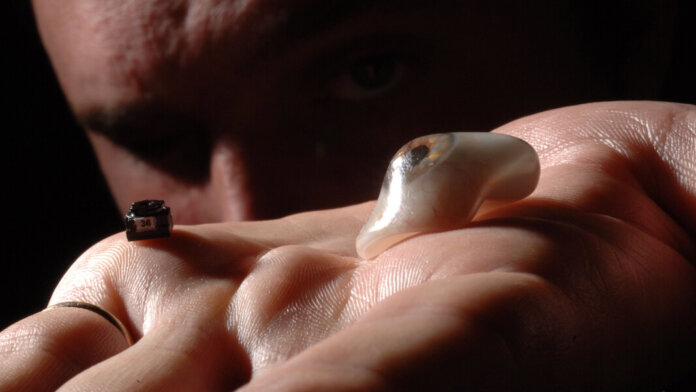When he was a child Rob Spence lost one of his eyes in a shotgun accident. Now as an adult, Rob is a filmmaker working on a documentary called Eyeborg: a thrilling effort to replace his missing eye with a prosthetic eye equipped with a video camera that can wirelessly record everything he sees. The project is an exciting journey for the imagination, tempting us with an approaching era where prosthetic components surpass the capabilities of natural human body parts. More importantly the project joins a series of recent examples that challenge us to contemplate a world where 24/7 surveillance of everything around us is not only possible, but common.
The prosthetic eye features a tiny CMOS camera—1.5 millimeters square to be exact. The video signal transmits wirelessly, picked up by an external radio-frequency transmitter smaller than the tip of a pencil eraser. The entire “bionic” package feeds off lithium polymer battery technology, and the data could be sent and recorded to a backpack enabled storage device.
To be clear, the Eyeborg project is not trying to give sight back to the blind (see the Argus II project for that). Rather, the objective is simply to create a video recording device that will be implanted into the eye for 24/7 lifestreaming. Of course, several other projects, notably Justin.tv, already offer this capability. The Eyeborg project is unique, however, in performing surveillance truly from an individual’s line of sight and also because it explores the implications of a future where our body parts can be augmented to exceed their natural capabilities.
Interestingly, it is the privacy implications, not the technology, that may be of most interest to people who encounter the Eyeborg project. Even though several countries such as Canada and the UK have installed tens of thousands of cameras to monitor their citizens, people categorize surveillance from an individual differently…and they should.
Government surveillance cameras are typically installed in public places and, in theory, there are restrictions on how and when this video can be used. But a person equipped with a 24/7 recording device can record you whenever they are in your presence…in your home, at your work, at a bar…anywhere, and the restrictions for what they can do with this data are wide open.
Eyeborg raises the specter of a world where recording devices are all around us without our knowledge. A camera phone is pretty hard to hide, but a 1.5-millimeter camera hiding behind someone’s eye or embedded into clothing or furniture can be impossible to spot. Science fiction has fathomed a total surveillance society for decades, but now increasingly that day is becoming a reality.
Something to consider is the fact that various individuals all over the world are undoubtedly already using miniaturized technology to record video and audio without our knowledge. Tiny 1.5-millimeter video cameras are a commodity device, and we are fooling ourselves if we think that terrorists, porn freaks, and the like haven’t already installed countless instances of these things in hotel rooms and elsewhere.
One interesting datapoint: If the carelessness with which today’s youth protects its privacy in places like Facebook and Second Life is any indication, future generations will be quite comfortable with further invasions of their personal privacy. This is a natural adaptation to a new reality that is unavoidable. Like it or not, surveillance of our lives is an ever increasing phenomenon, and as they say “if you can’t beat ’em, join ’em.”
Image Credit: Eyeborg Project



